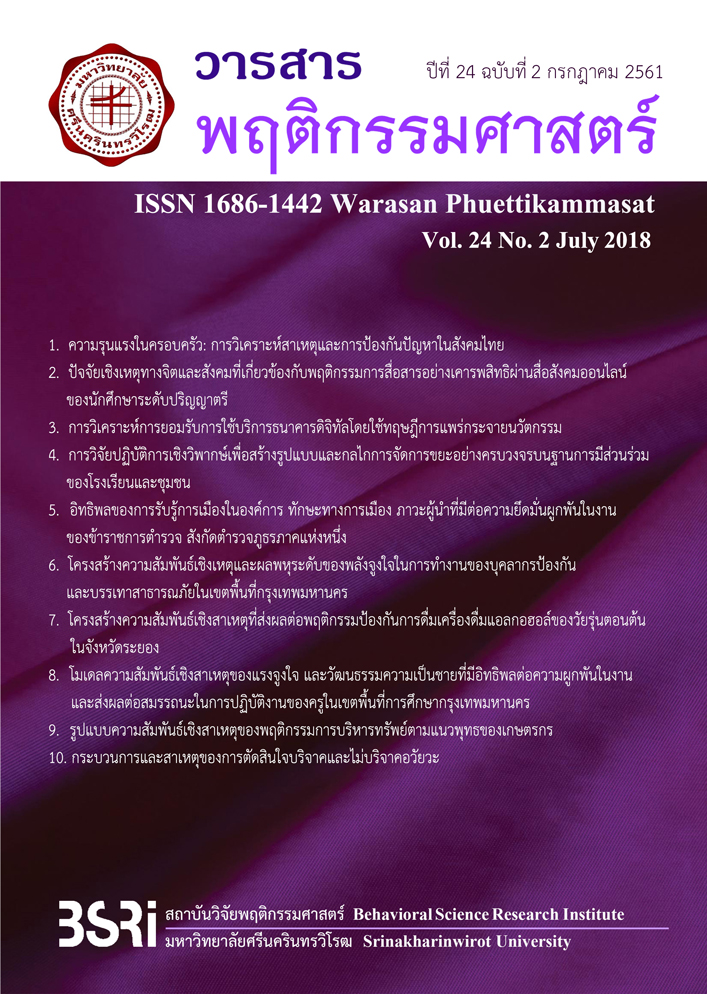Causal Relationship Model of Motivation and Masculine Culture Influencing Teachers’ Job
คำสำคัญ:
โมเดลความสัมพันธ์เชิงสาเหตุ, แรงจูงใจ, วัฒนธรรมความเป็นชาย, ความผูกพันในงาน, สมรรถนะในการปฏิบัติงานบทคัดย่อ
การวิจัยครั้งนี้มีวัตถุประสงค์เพื่อพัฒนาโมเดลความสัมพันธ์เชิงสาเหตุของแรงจูงใจ และวัฒนธรรมความเป็นชายที่มีอิทธิพลต่อความผูกพันในงาน และส่งผลต่อสมรรถนะในการปฏิบัติงานของครูในเขตพื้นที่การศึกษากรุงเทพมหานคร โดยผู้วิจัยใช้การวิจัยแบบผสานวิธีโดยการศึกษาไปพร้อม ๆ กันโดยใช้การวิจัยเชิงปริมาณเป็นงานวิจัยหลัก และใช้การวิจัยเชิงคุณภาพเป็นงานวิจัยเสริมเพื่อเพิ่มมุมมอง โดยกลุ่มตัวอย่างของการวิจัยเชิงปริมาณ ผู้วิจัยได้แจกแบบสอบถามกับครูสพฐ. ในเขตพื้นที่การศึกษากรุงเทพมหานคร จำนวน 272 คน ส่วนผู้ให้ข้อมูลหลักของการวิจัยเชิงคุณภาพเป็นครูกลุ่มเดิม จำนวน 12 คน เครื่องมือที่ใช้ในการวิจัยเป็นแบบสอบถามกับแบบสัมภาษณ์ การวิเคราะห์ข้อมูลใช้โปรแกรมคอมพิวเตอร์ โปรแกรมสำเร็จรูป LISREL และการวิเคราะห์เนื้อหาสถิติที่ใช้ในการวิเคราะห์ข้อมูล ได้แก่ ค่าความถี่ ร้อยละ ค่าเฉลี่ยเลขคณิต ส่วนเบี่ยงเบนมาตรฐาน และค่าสถิติอื่น ๆ ที่เกี่ยวข้องกับการวิเคราะห์โมเดลสมการโครงสร้าง ผลการวิจัยสามารถสรุปได้ดังนี้ 1. ผลการวิจัยเชิงปริมาณ ผลการวิจัยพบว่าแรงจูงใจ วัฒนธรรมความเป็นชาย และความผูกพันในงานร่วมกันอธิบายสมรรถนะในการปฏิบัติงานได้ร้อยละ 75 ซึ่งตัวแปรสำคัญที่อธิบายได้มากที่สุด คือ ความผูกพันในงาน รองลงมา คือ วัฒนธรรมความเป็นชาย ส่วนแรงจูงใจมีค่าอิทธิพลทางตรงเป็นบวก แต่ไม่มีนัยสำคัญทางสถิติ 2. ผลการวิจัยเชิงคุณภาพ ตัวแปรที่เกี่ยวข้องกับสมรรถนะในการปฏิบัติงานของครูประกอบด้วย 1) แรงจูงใจ ได้แก่ การให้รางวัลทางการเงิน 2) วัฒนธรรมองค์การ ได้แก่ ความเป็นพี่เป็นน้อง 3) ความผูกพันในงาน ได้แก่ การสนับสนุนทางกายภาพ 4) สมรรถนะในการปฏิบัติงาน ได้แก่ ทักษะในการสอน 3. การเปรียบเทียบผลการวิจัยระหว่างการวิจัยเชิงปริมาณและการวิจัยเชิงคุณภาพ ตัวแปรที่ศึกษาทั้ง 4 ตัวแปรไม่มีประเด็นที่เหมือนกัน มีแต่ประเด็นที่ต่างกัน ประกอบด้วย 1) แรงจูงใจ ประเด็นที่ต่างกัน คือ การทำให้งานมีความสำคัญกับการให้รางวัลทางการเงินต่างๆ 2) วัฒนธรรมความเป็นชาย ประเด็นที่ต่างกัน คือ วัฒนธรรมความเป็นชายกับวัฒนธรรมความเป็นพี่เป็นน้อง 3) ความผูกพันในงาน ประเด็นที่ต่างกัน คือ Psychological Safety (Guarantees) กับการสนับสนุนทางกายภาพ 4) สมรรถนะในการปฏิบัติงาน ประเด็นที่ต่างกัน คือ การรับรู้บทบาทในงานกับทักษะในการสอน
Downloads
References
ไชยา ยิ้มวิไล. (2557). พัฒนาการรัฐประศาสนศาสตร์และบริหารรัฐกิจ: จากอดีตสู่ปัจจุบันและอนาคต. กรุงเทพฯ: สำนักพิมพ์มหาวิทยาลัยศรีปทุม.
วิริณธิ์ ธรรมนารถสกุล. (2547). ปัจจัยเชิงสาเหตุพหุระดับของผลการปฏิบัติงานของพยาบาลวิชาชีพ: ศึกษาปัจจัยสภาพแวดล้อมในการทำงาน และปัจจัยระดับบุคคล. (วิทยานิพนธ์ปริญญาดุษฎีบัณฑิต). มหาวิทยาลัยศรีนครินทรวิโรฒ, กรุงเทพมหานคร.
สำนักพัฒนาระบบบริหารงานบุคคลและนิติการ สำนักงานคณะกรรมการการศึกษาขั้นพื้นฐาน. (2553). คู่มือเส้นทางครูมืออาชีพสำหรับครูผู้ช่วย. กรุงเทพฯ: โรงพิมพ์ชุมนุมสหกรณ์การเกษตรแห่งประเทศไทย จำกัด.
Alkhalaf, A. H. (2017). Identifying employee engagement factors in the oil and energy industry in Saudi Arabia. (doctoral dissertation). Pennsylvania State University, Pennsylvania.
Armstrong, M., &Taylor, S. (2014). Armstrong’s handbook of human resource management practice. 13th ed. London: Kogan Page.
Byars, L. L., & Rue, L. W. (2008). Human resource management. 9th ed. New York: McGraw-Hill.
Chien, H. C. (1984). A comparison of teacher educators’ perceptions of expected performance with student teachers’ perceptions of actual performance in Taiwan. (doctoral dissertation). University of Georgia, Georgia.
Colquitt, J. A., Lepine, J. A., & Wesson, M. J. (2009). Organizational behavior: Improving performance and commitment in the workplace. New York: McGraw-Hill.
Coombs, A. J. (2017). Teacher educators’ approaches to assessment. (Master’s thesis). Queen’s University, Ontario.
Cooper, K. E. (2009). Go with the flow: Examining the effects of engagement using flow theory and its relationships to achievement and performance in the 3-dimensional virtual learning environment of second life. (doctoral dissertation). University of Central Florida, Florida.
Gerson, R. F., & Gerson, R. G. (2006). Positive performance improvement: A new paradigm for optimizing your workforce. CA: Davies-Black Publishing.
Greenberg, J. (2011). Behavior in organizations. 10th ed. Harlow: Pearson Education.
Hofstede, G., Hofstede, G. J., & Minkov, M. (2016). National culture. Retrieved from https://geert-hofstede.com/national-culture.html
Kahn, W. A. (1990). Psychological conditions of personal engagement and disengagement at work. Academy of Management Journal, 33(4), 692-724.
Rai, R. (2015). Building employee engagement through organizational culture: An empirical study of Indian IT industry. Prestige International Journal of Management and Research, 8(9), 15-20.
Shahzad, F., Iqbal, Z., & Gulzar, M. (2013). Impact of organizational culture on employees job performance: An empirical study of software houses in Pakistan. Journal of Business Studies Quarterly, 5(2), 56-64.
Shu, Y. (2015). The impact of intrinsic motivation on the effectiveness of leadership style towards on work engagement. Contemporary Management Research, 11(4), 327-350.
Springer, G. J. (2011). A study of job motivation, satisfaction, and performance among bank employees. Journal of Global Business, 5(1), 29-42.
Wilcox, K. E. (1979). Motivation, central life interests, voluntarism, and demographic variables as predictors of job satisfaction and perceived performance of teachers. (doctoral dissertation). University of Kansas, Kansas.
Williams, R. S. (2002). Managing employee performance: Design and implementation in organizations. London: Thomson Learning.
Yousaf, A., Yang, H., & Sanders, K. (2015). Effect of intrinsic and extrinsic motivation on task and contextual performance of Pakistani professionals: The mediating role of commitment foci. Journal of Managerial Psychology, 30(2), 133-150.
Downloads
เผยแพร่แล้ว
How to Cite
ฉบับ
บท
License
สถาบันวิจัยพฤติกรรมศาสตร์ มหาวิทยาลัยศรีนครินทรวิโรฒ
114 ซอยสุขุมวิท 23 ถนนสุขุมวิท แขวงคลองเตยเหนือ เขตวัฒนา กรุงเทพฯ 10110
โทร 02-649-5000 ต่อ 17600


